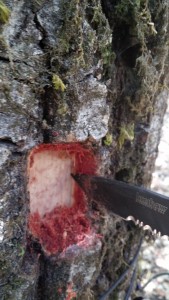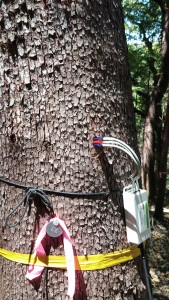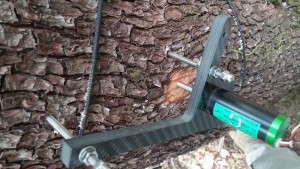
Trees must pull water from soil and rock, where it is held at tension, to their leaves, where it evaporates to the atmosphere through open stomata. This process, called transpiration, is a major component of the hillslope water budget and can dramatically affect the local climate by lowering air temperature and increasing water vapor concentrations. Understanding how trees use water is a major topic of research at the Angelo Coast Range Reserve. How does the seasonality of transpiration differ between species? At what water content (and potential, or tension) in the subsurface do trees become so stressed that they close their stomata to prevent embolisms (damage to their vascular tissues)? How does rock type influence how hard trees must pull to extract water from the vadose (unsaturated) zone? How do trees access water to continue to transpire throughout the summer drought in Mediterranean climates?

To answer these questions, researchers are monitoring tree physiological response to environmental conditions in the Angelo Coast Range Reserve. Sapflow (the vertical ascent of water through xylem) can be measured using a simple sensor consisting of three prongs placed into the sapwood of the tree. The central prong emits a heat pulse, and the two surrounding prongs sense changes in temperature. Flowing sap advects the heat pulse so that a temperature rise is sensed sooner in the upper temperature probe. This principle enables the sapflow velocity to be determined.


As the tree ‘pulls’ water up from below, tension increases in the water column in the xylem. This suction can influence the size of the tree trunk, which can be measured with very precise piston dendrometers. These sensors capture the diurnal size variation due to changes in both water content and potential as well as tree growth.
